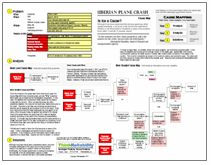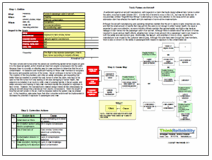Four minutes after take-off on April 1, 2011, an ATR-72 crashed just past Roshchino International Airport in Tyumen, Siberia. This type of plane has had previous issues with dealing with ice, and has been banned from flying in conditions likely to result in icing in the United States. However, it has not yet been determined that ice was related to the crash.
To begin a Cause Map – an intuitive, visual root cause analysis – we look at the impacted goals. In this case, the fatalities and injuries are the primary impact, to the safety goal. Additionally, this incident, combined with previous air safety issues in Russia (such as the September 2011 crash that killed a Russian hockey team), have eroded public confidence in air safety in the country. This could be considered an impact to the customer service and production goal. The plane split into three pieces on impact, which affects the property goal. Searches and subsequent investigations will likely impact the labor goal.
 Once the impacts to the goals have been determined, begin the Cause Map with these impacted goals, and ask “Why” questions. More detail can be added as the investigation progresses. In this case, the fatalities and injuries were likely caused by the plane’s impact with the ground. Other mechanical issues are still a possibility; however, the crew did not report any malfunctions prior to the crash. Disruption of air flow over the wings and jamming of ailerons can be caused by accumulation of ice on the plane. It has been determined that there was inadequate de-icing agent on the plane, either because it was not applied (according to the deputy head of the airport where the plane took off) or was not applied properly (according to the head of the Russian air transportation agency). It is known that the weather was cold (the plane landed in a snowy field) and that ATR-72s have trouble with icy conditions, to the point where they have been banned from flying in conditions likely to cause ice in the US.
Once the impacts to the goals have been determined, begin the Cause Map with these impacted goals, and ask “Why” questions. More detail can be added as the investigation progresses. In this case, the fatalities and injuries were likely caused by the plane’s impact with the ground. Other mechanical issues are still a possibility; however, the crew did not report any malfunctions prior to the crash. Disruption of air flow over the wings and jamming of ailerons can be caused by accumulation of ice on the plane. It has been determined that there was inadequate de-icing agent on the plane, either because it was not applied (according to the deputy head of the airport where the plane took off) or was not applied properly (according to the head of the Russian air transportation agency). It is known that the weather was cold (the plane landed in a snowy field) and that ATR-72s have trouble with icy conditions, to the point where they have been banned from flying in conditions likely to cause ice in the US.
Officials aren’t ready to name the icing issues as a cause of the crash. Further investigation will determine which causes did contribute. In the meantime, all the information that is known can be captured on a Cause Map. Causes can then be added – or crossed off – as more information becomes available.
To view the Outline and Cause Map, please click “Download PDF” above.









